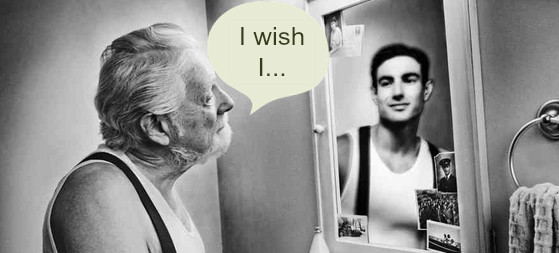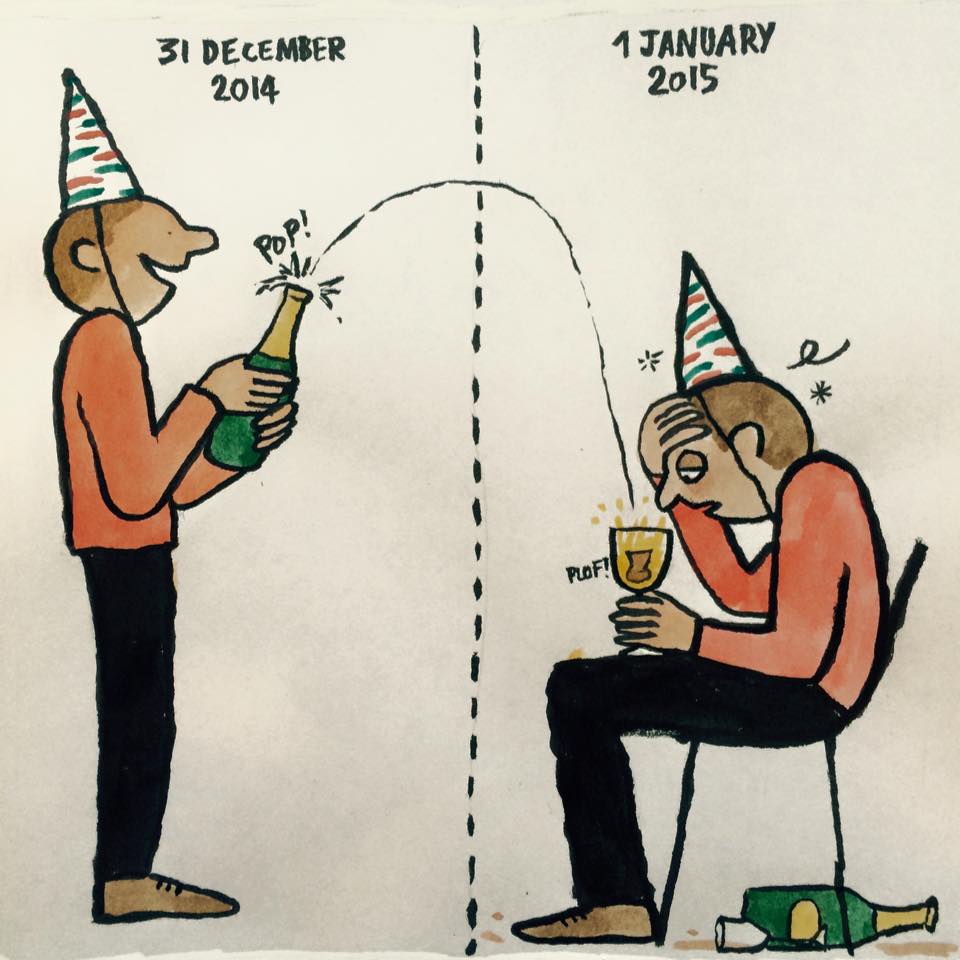“Maybe all one can do is hope to end up with the right regrets”. Arthur Miller.
Hopefully! I surely have had my fair share of mistakes, and consequently a few regrets too although to be honest, I don’t really know if the are of the right kind. There are a couple of things, or maybe more, that I would probably have done differently if given the chance but…. this is now water over the bridge and it’s no use crying over spilt milk! What about you? Do you have any regrets?
Let’s talk about regrets today.
Aim: to teach students how to express regrets using the structures I wish/if only
Level: B2
Lead in: Play this 45-second audio clip and ask students to try to identify the next structure you are going to teach them.
1. I WISH (THAT)/IF ONLY+SIMPLE PAST
Introducing: display the picture below and draw students’ attention to the reflection of the man in the mirror. Ask: What does the old man see in the mirror? What is he thinking?

Listen to the students’ suggestions and use each of them to introduce
- I wish (that)/if only + simple past
I wish/if only I was younger or I wish I was in my twenties.
I wish/if only I was handsome or I wish I was stronger… etc
Explaining the grammar: we use this structure to express a desire for a situation that does not exist right now in the present. A wish is a desire to change a real situation into an unreal one. This unreal situation is expressed in the simple past. In a wish sentence, the simple past does not indicate past time; it only indicates that the situation is unreal.
- That is optional.
I wish/if only I lived in the countryside, but I don’t. I live in a city.
- Were is used for both singular and plural subjects in a formal context
I wish/if only he were younger, but he’s not. He is old.
Practising. Guided practice.
1. Pictures.
Students look at the pictures and make a sentence using “wish”. Flip them to see a possible answer.
2. The power of music. A meditation activity.
Ask students to close their eyes. Turn off the lights, close windows and play some soft music to create the right atmosphere and help them relax. Tell them you are going to ask them some questions about themselves. Use a low, slow, soothing voice. They will need to imagine how they would answer the question using the structure I wish/if only + past tense. Read out the questions one by one, take your time and remember to keep your voice slow and calm.
- If you could change something in your body, what would it be?
- If you could change something about your personality, what would you change?
- If you could change anything about your job, what would it be?
- If you could change something about you partner, what would it be?
- If you could change something about your life, what would it be?
- If you could change one thing in the world, what would it be?
Practising. Freer practice.
Students in pairs talk about their anwers to the questions above. Let them choose the ones they want to talk about as some answers could be a bit personal.
2. I WISH (THAT)/IF ONLY+ WOULD
Introducing: display the picture below and ask students to describe what they see.

Now, ask students to provide a sentence with “wish” about the picture. At this stage, students will probably suggest “She wishes he didn’t see so much TV”.
Draw students’ attention to the girl’s mood and offer this alternative sentence
She wishes/if only he wouldn’t watch so much football
Explaining grammar: the structure wish+ (that)/if only +would is used to talk about what other people do that annoys or irritates us and that we wish was different.
Practising. Guided practice.
Play the video and ask students to make sentences based on the pictures using I wish+would.
Practising. Freer Practice.
Students in pairs answer these questions:
- What annoys you about living where you live now?
- What annoys you most about living at home with your family?
- What annoying habits does your best friend have?
- What is the most annoying thing about your partner?
- Is there anything about your teacher that annoys you? 🙂
3. I WISH/IF ONLY + (THAT) + PAST PERFECT
Introducing. Display the picture below and ask: do you think he has any regrets?
Elicit: He wishes he hadn’t drunk so much or he wishes he hadn’t danced so much

Photo by JeanJulien
Explaining the grammar:
We use ‘wish’ + past perfect to talk about regrets from the past. These are things that have already happened but we wish they had happened in a different way.
Practising. Guided Practice.
Introduce the activity by asking students to think back to the time when they were teenagers. Ask them if they have any regrets.
For example: I wish I hadn’t given up my studies.
Tell students they are going to watch a video of a song Mistakes of my Youth by the American rock band Eels. In this video, the singer thinks back on his childhood and all the things he did wrong. Ask them to watch the video and write down as many I wish/if only + past perfect sentences they can think of based on the video.
Freer practice.
What are your regrets when you think back on your life? Make a list of three regrets and tell the story to your partner.
ADDITIONAL ACTIVITIES
- Writing a dialogue. Working in pairs, the students should write a conversation among two friends who are complaining about their boyfriends/girlfriends or bosses. Tell them to use as many I wish/if only sentences as possible. Ask students to act it out.
- Writing about being the opposite gender. Ask students to write a compositions about how their lives would be different if they were the opposite sex. Ask them to use I wish/ if only sentences
- Discussion about cultural customs. Lead a class discussion about what customs in their country wish were different.

One of my faves too, Virginia! Thanks for your comment!
Thank you so much for this amazing lesson!!!!! =) Appreciated!!!!
Thanks for your enthusiasm and kind words!!!
My Gosh, incredible work!!!! Life saver, thank youuuuuu. Big fan!!!!
Glad you like it. Thanks for your feedback!
This is amazing! Thank you for the most interesting ideas! <3
Thanks for your comment Diego!
Glad you find them useful!!
I ve used your lesson plans several times
they ‘re really great and really helpful
thanks for posting them
greetins from Spain!
What a great website! Thanks for sharing!
I am glad it has saved you some time!
Wow! Very useful! I’m glad I found this great material that I’ll use tomorrow.
Thanks Cristina!
My pleasure!
This looks great. I am so glad I found it. Thank-you!
Thanks Liana!!! Really encouraging!
Great job. Thanks for sharing! Amazing flow .. one leading to the next… 🙂
Thanks!
I am really happy I have found this site. It’s just what I had been looking for! Thanks for your great work.
And one of my favourite posts on the blog, too!
Thanks for your comment! Glad you liked it!
Thanks a million! A well-designed lesson and such nice ideas.
One of the best lessons I have ever seen for this topic! Thank you very much!
That’s very kind of you.
There are some other great lessons on the blog, if I may say so! 🙂
Explore a bit and tell me what you think
Hi Cristina,
This is one of the best classes I’ve ever found on the internet.
Thank you!
Best regards,
Luc Daenen
TEFL Teacher Barcelona
I am happy you found it useful!
thanks very much, it was too useful to explain my class
Thanks Nataly! Very kind of you!
It’s amazing!!!! It such a useful and interesting lesson!!! It’s so practical!!! Great respect to you!!!!!!!!!!!!!
Thanks Vanessa! 🙂 It is also one of my fave lessons!
WOOW! I came across your blog just by chance and I must admit I was amazed. Thanks for sharing such a wonderful class!!! You’re a genius and also an inspiration. Now I want all my classes to be like this one.
Thanks Micaela. This is probably one of my favourite activities on the blog.
This activity really helped my ss understanding this grammar topic. Oh, I wish I were such a good teacher as you are Cristina! Jajaja, thanks a lot 🙂
And keep uploading activities please!!
Thanks Galine! I am glad you like it!
Thanks a lot! That genius!
Hi Alice
Thanks for your comment!
You’re right. In English “that’ is always omitted in this structure, at least in spoken Interactions. In fact, omitting it poses no problem to Spanish native speakers, moreover when it’s a structure taught at B2 levels where students’ command of the language is already quite good.
However, grammar books offer the possibility of using or not ‘that’ in this structure. Ironically, first we teach them it is grammatically correct to use it, and then we ask them to drop it altogether.
Fortunately, as I said, it’s not a problem for them
Great content! Big fan of the use of visuals in class, I’m curious about the use of that in “I wish”.
You say it’s optional, but I used to think it was an appropriation from Spanish, in English we don’t use that often. Let me know your thoughts!
Thanks
Thanks Agustina! That’s really encouraging!
OMG Cristina, you’re amazing! Such a creative teacher! I’ll try out these ideas tomorrow! I wish I had had a “Cristina” in the classroom when I was a student
Thanks Laura! Very happy it worked for you!
Hi Cristina! Thanks so much for sharing your ideas! I used your lesson plan proposal and it worked really well. “I wish I had found your website earlier!”
Thank you Felix! Very encouraging!
Maybe. That was relaxing but the main reason is that the examples and techniques used help us to learn the lesson in a few minutes.
Thank you Felix. I am very happy you liked the lesson! What did you like best? the meditation activity, perphaps?
I liked this lesson.
Your blog makes English is a bit more interesting.
Hi Teresa,
Thanks very much for the kind comments which I really appreciate.
I am very happy you like the blog. 🙂
Critina, I admire you a lot. What a good teacher you are!!!!
hahahah nice!
Great activities…If only I had had that idea before
Thank you for your kind words!
Thanks, great work!